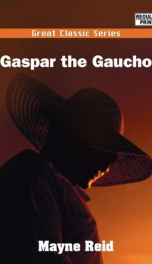Gaspar the Gaucho

an excerpt from: Chapter One. The Gran Chaco. Spread before you a map of South America. Fix your eye on the point of confluence between two of its great rivers-the Salado, which runs south-easterly from the Andes mountains, and the Parana coming from the north; carry your glance up the former to the town of Salta, in the ancient province of Tucuman; do likewise with the latter to the point where it espouses the Paraguay; then up this to the Brazilian frontier fort of Coimbra; finally draw a line from the fort to the aforementioned town-a line slightly curved with its convexity towards the Cordillera of the Andes-and you will thus have traced a boundary embracing one of the least known, yet most interesting, tracts of territory in either continent of America, or, for that matter, in the world. Within the limits detailed lies a region romantic in its past as mysterious in its present; at this hour almost as much a terra incognita as when the boats of Mendoza vainly endeavoured to reach it from the Atlantic side, and the gold-seekers of Pizarro-s following alike unsuccessfully attempted its exploration from the Pacific. Young reader, you will be longing to know the name of this remarkable region; know it, then, as the -Gran Chaco.- No doubt you may have heard of it before, and, if a diligent student of geography, made some acquaintance with its character. But your knowledge of it must needs be limited, even though it were as extensive as that possessed by the people who dwell upon its borders; for to them the Gran Chaco is a thing of fear, and their intercourse with it one which has brought them, and still brings, only suffering and sorrow. It has been generally supposed that the Spaniards of Columbus-s time subdued the entire territory of America, and held sway over its red-skinned aborigines. This is a historical misconception. Although lured by a love of gold, conjoined with a spirit of religious propagandism, the so-called Conquistadores overran a large portion of both divisions of the continent, there were yet extensive tracts of each never entered, much less colonised, by them-territories many times larger than England, in which they never dared set foot. Of such were Navajoa in the north, the country of the gallant Goajiros in the centre, the lands of Patagonia and Arauco in the south, and notably the territory lying between the Cordilleras of the Peruvian Andes and the rivers Parana and Paraguay, designated -El Gran Chaco.- This vast expanse of champaign, large enough for an empire, remains to the present time not only uncolonised, but absolutely unexplored. For the half-dozen expeditions that have attempted its exploration, timidly entering and as hastily abandoning it, scarce merit consideration. And equally unsuccessful have been all efforts at religious propagandism within its borders. The labours of the padres, both Jesuit and Franciscan, have alike signally failed; the savages of the Chaco refusing obedience to the cross as submission to the sword. Three large rivers-the Salado, Vermejo, and Pilcomayo-course through the territory of the Chaco; the first forming its southern boundary, the others intersecting it. They all take their rise in the Andes Mountains, and after running for over a thousand miles in a south-easterly direction and nearly parallel courses, mingle their waters with those of the Parana and Paraguay. Very little is known of these three great streams, though of late years the Salado has received some exploration. There is a better acquaintance with its upper portion, where it passes through the settled districts of Santiago and Tucuman. Below, even to the point where it enters the Parana, only a strong military expedition may with safety approach its banks, by reason of their being also traversed by predatory bands of the savages. --This text refers to the Kindle Edition edition.
Info about the book
Author:
Series:
Unknown
ASIN:
B0082WA1K2
Rating:
5/5 (2)Your rating:
0/5
Languge:
English
Users who have this book
Users who want this book
What readers are saying
What do you think? Write your own comment on this book!
write a commentGenre
if you like Gaspar the Gaucho try:
Other books by this author
Do you want to read a book that interests you? It’s EASY!
Create an account and send a request for reading to other users on the Webpage of the book!


